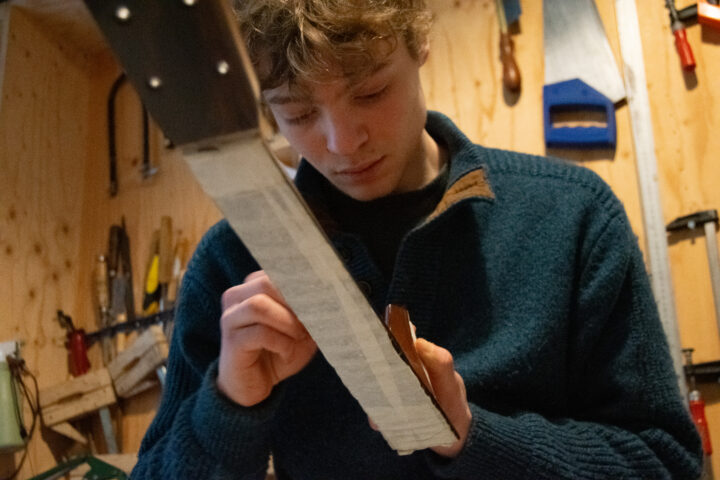It’s starting to seem like the 21st Century version of “Virginia is for Lovers” might just be “Virginia is for Luthiers” – particularly that neck of the Virginia woods centered around Wayne Henderson. Henderson and his circle of friends, family and peers (which, truth be told, extends beyond the state line) have cropped up now and again in the pages of the Fretboard Journal as well as here in the Bench Press, but usually in the guise of flattop builders in the Martin tradition. Jackson Cunningham is in both that circle and that neck of the woods (Grant, Virginia, specifically), but he came to our attention for his astounding archtop guitars, situated firmly in the ’20s and ’30s Gibson tradition. Even his flattops are inspired by old Gibsons. We reached out to ask him about his work…
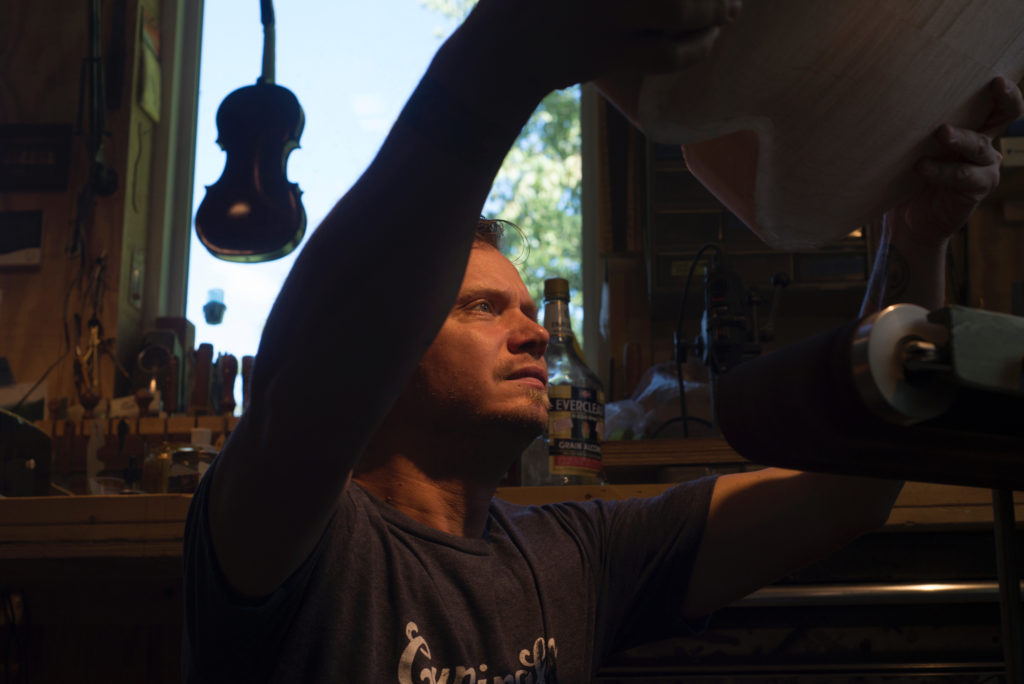
Fretboard Journal: How did you get started?
Jackson Cunningham: I’ve been a woodworker and musician since I was very young, growing up in Southern Oregon. My stepfather was a carpenter and woodworker, so I was around it and learned to work wood early on. I’ve been playing music since I was eight years old, so I think those paths were bound to cross at some point. I kind of naturally was interested in building, but didn’t really ever know where to start. I had several “repair” projects and things of that sort that I carried around with me for years, half-built guitars and guitars that needed lots of work. I was doing carpentry and playing a lot of bluegrass; I just never really had the time or space to set up and actually start.
I made a move from the West Coast out to where the rest of my family lives, here in Virginia. Shortly after that, I was introduced to a woman named Audrey Hash Ham who built fiddles and dulcimers. She had instrument making in her family: Her father, Albert Hash, was a well-known fiddle maker and fiddler who got lots of local instrument makers their start, including Wayne Henderson.
She was a real easy-going and kind lady. When I visited, she would always cook dinner and tell lots of stories, and really was encouraging and enthusiastic about me building a fiddle. She had a really cool shop up on the end of a gravel road up in the mountains. She had all sorts of homemade sanders and saws her dad had made back before internet and tool catalogs and stuff. I remember the shop was filled with all sorts of fiddle parts, stacks of old curly maple, old pictures of local musicians. It had a real old-timey feel – I don’t think she had any modern tools at all.
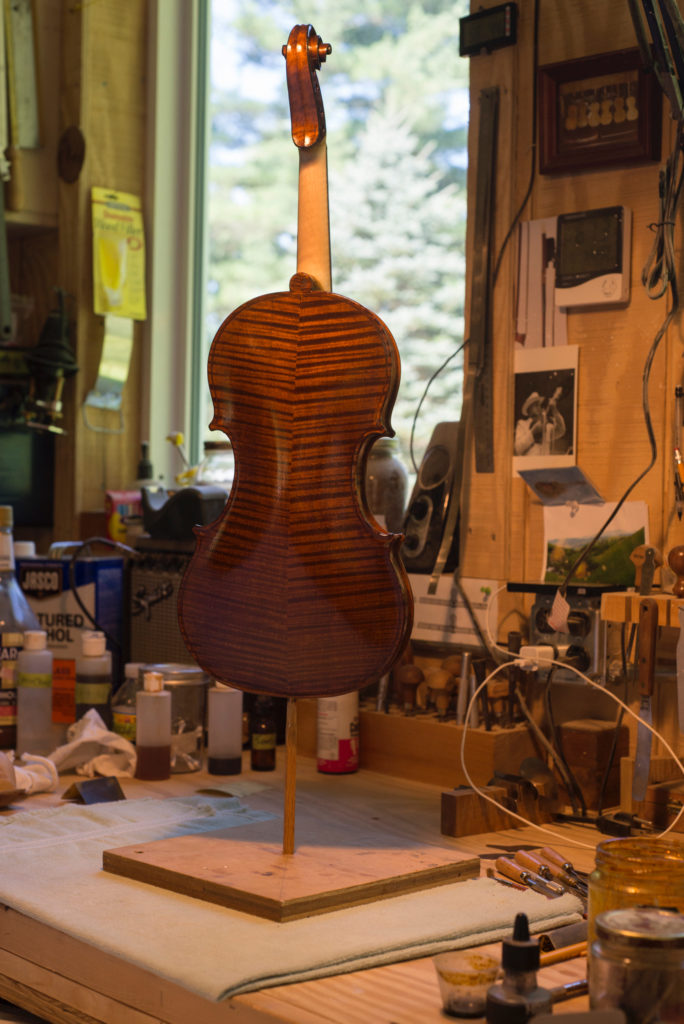
She gave me a piece of curly maple with a fiddle neck penciled on it and told me to carve it out and come back when it was done. After that she gave me a piece of old Sugar maple to carve into a back. She bent me a set of sides with a homemade jig her dad made out of aluminum. She had some piles of old violin making books that looked like they had been read over a thousand times – she sent me home with them, but joked that I should just listen to her and not what I read…
I had not really even thought about making fiddles in particular at that point, I just knew I wanted to build instruments. I think I was really inspired by my introduction to her. I decided to try building a fiddle and got hooked, the woodworking came natural to me, and she made it a really fun experience.
She passed away a few years ago but I’ll always remember her as a good friend and the one who got me started.
I built a few fiddles that family and friends bought, I think mostly to be encouraging. After I had built several I started getting more and more people taking notice and interested in buying them, so I started visiting other fiddle makers around, like Alfred Michels and Joe Thrift, just trying to learn as much as possible. I read a lot of books and scoured the internet for information.
FJ: What made you decide to add guitars to your repertoire?
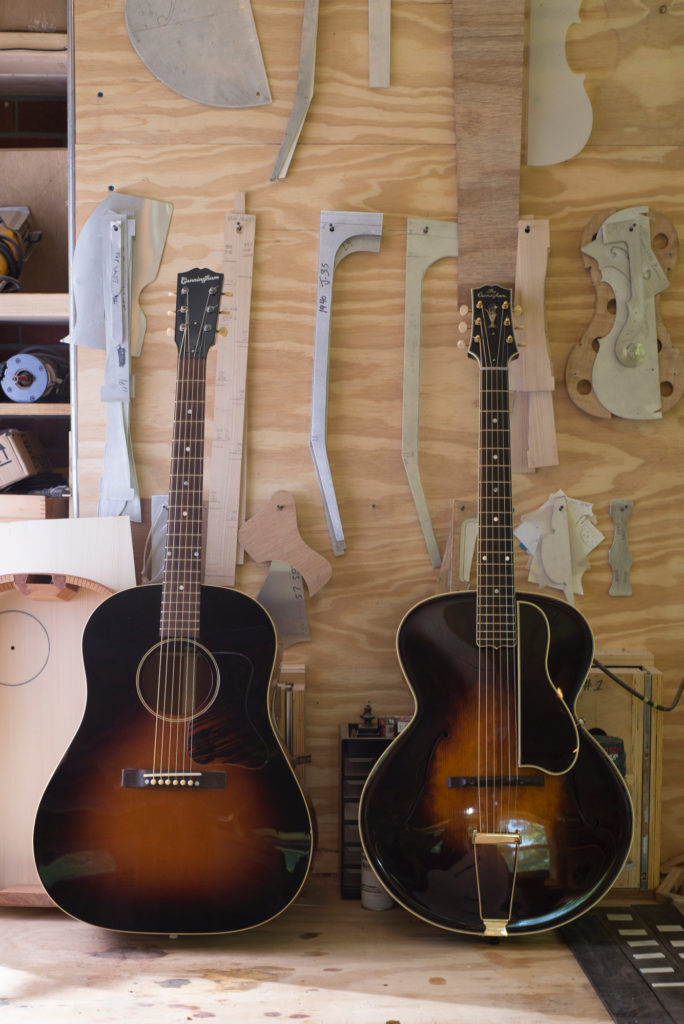
JC: Well, I play a lot more guitar than fiddle! I’m not much of a fiddler really, just a closet fiddler. I wanted something I could play around a bit more. I was listening to a lot of Carter Family music and started looking into buying an old archtop, but didn’t have any luck finding a late ‘20s guitar like Maybelle Carter played. I figured if I can make a fiddle, I can make a guitar – after all they both have similar arching and body… it just seemed like something nobody was doing around here. We have lots of Martin-style flattop builders, but nobody building anything like the old ‘20s archtops.
And for my flattops, I guess kind of the same thing: I am just building what I want to play, and I wanted a late ’30s/early ’40s J-35, so I figured I could start making them. The archtop market is a bit smaller, so I thought too it wouldn’t hurt to be a bit more versatile in what I can build.
I was also living just down the road from Wayne Henderson, in Rugby, Virginia. I had been building fiddles for about six years and would often run down there to his shop anyhow, so I started hanging out down at Wayne’s shop and seeing tons of guitars go out and come through the door. It was pretty amazing – anybody who has spent time in his shop knows what I mean. I could run down anytime of the night and watch him work on stuff and ask him questions. He is a lot like Audrey in that he always had stories about past musicians and local characters that made the whole guitar building thing so much fun, not just the guitars but the local music and musicians.
Also, I should mention Don Wilson. He’s a great guitar maker from Jacksonville, Florida, who has family ties to Virginia. I met him in Wayne Henderson’s shop and he helped me in guitarmaking quite a bit in the beginning. I still get a lot of advice and help from him. Don helped me get my shop set up right; he’s not just a guitarmaker but really has a knack for production and building jigs and stuff like that. He built a lot of my jigs that I use here in the shop. Herb Key, another [builder] I met at Wayne’s, has helped a lot, too. He knows so much about those old Gibsons, and he always has something cool on his bench. Anytime I’ve got Gibson questions, I turn to him. I’ve been really lucky to have got the help from all these guys.
FJ: Are there specific guitars you’re using for inspiration, or is it more just the era?
JC: Most of my guitars are inspired by the music and players I listen to – lots of bluegrass and old time, country, and lately some Texas fiddling… The 1920s Gibson L-5s I make were inspired by Maybelle Carter’s guitar and playing, and the late ’30s to ’40s Gibson Jumbos are really cool guitars. There has been so much good old music made on those guitars. I guess most of the instruments I’m inspired by are pre-war, but featured in music that spans many decades past that era.
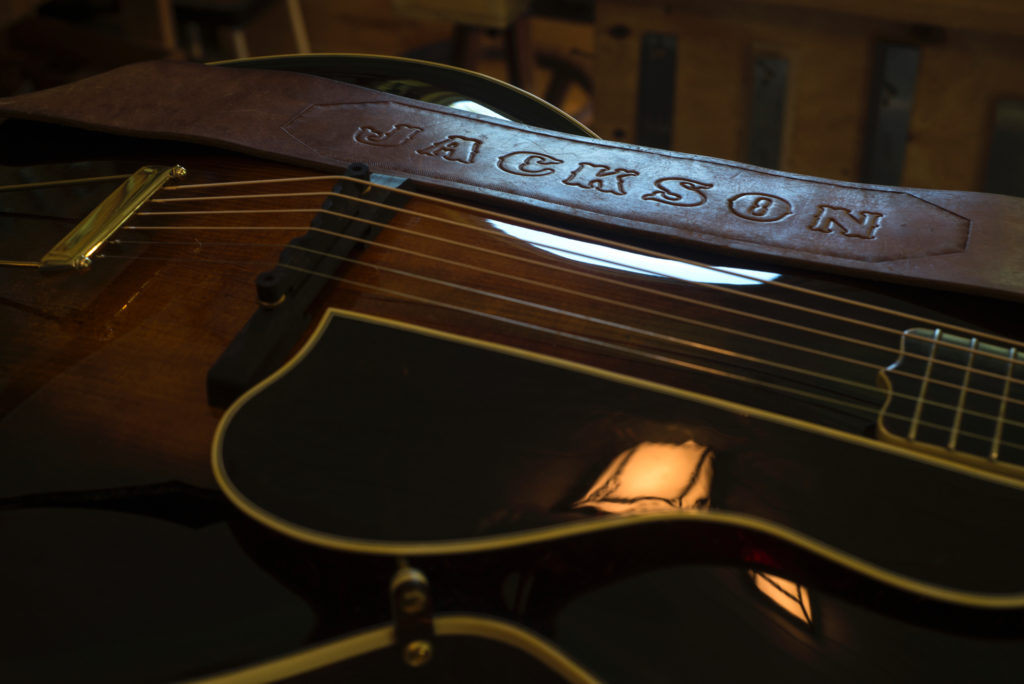
FJ: Can you tell us about the materials you’re using?
JC: Archtops and flattops, I use Red spruce for the tops. There is a lot of really good Red spruce available right now, coming from down in North Carolina, mostly. I have cut some myself up on the mountain here in Virginia, right up behind my house. I used to work for the park service so when there was a blowdown I would cut it up. Every once in a while I would get a good one. I actually have a few Red spruce growing in my yard.
Red spruce is all I’ve ever used on guitars. My understanding that all these old guitars were made with it so I figured why use anything else? But I do intend to experiment with some Engelmann and Sitka just to see for myself the difference.
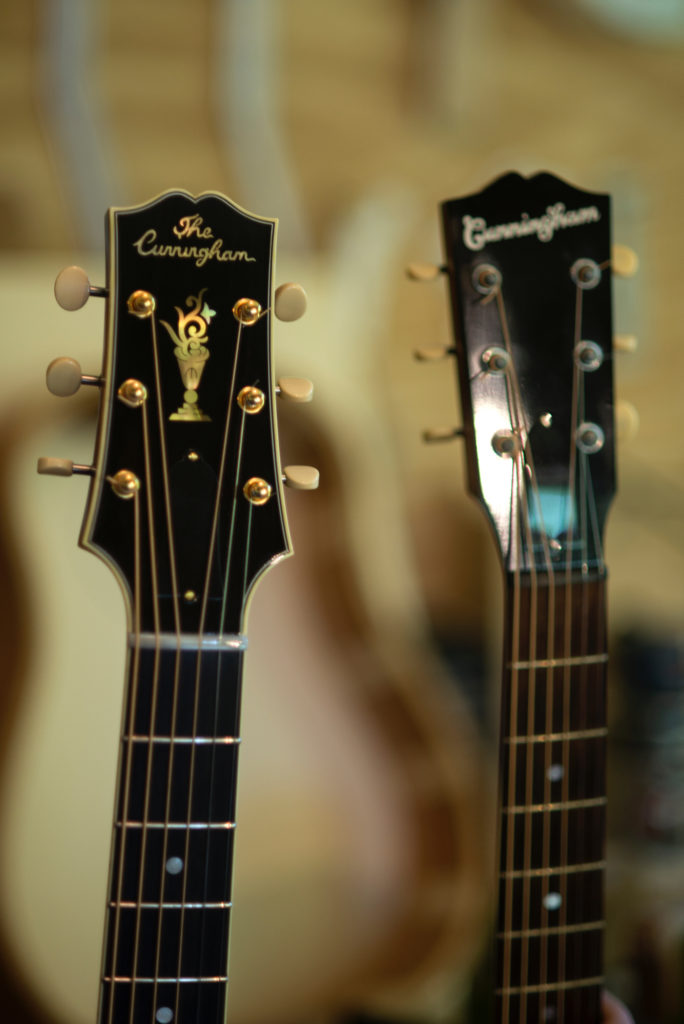
For the archtops, I use Eastern maple and Sugar maple for backs and sides and mostly Sugar maple for the necks, ebony fingerboards and bridges. I make all the celluloid pickguards, ebony bridges and brass tailpieces for the archtops here in the shop, as well, trying to keep it as close as I can to 1920’s style. I have not done anything too far off the beaten path, sticking mostly to what the originals would have had.
I use Honduran mahogany for the jumbo guitars, Brazilian rosewood for the fingerboards/bridges – again, basically sticking to the traditional norm for these models. I got plans for some Brazilian rosewood jumbo guitars down the road sometime.
For finish, I’m using spirit varnish for the archtops and lacquer for the flattops.
FJ: What made you decide to build the archtops in batches, rather than on a custom order basis, like your fiddles?
JC: I had talked with several builders about the way they build, and several mentioned building in batches. Steve Gilchrist and Don Wilson had encouraged me to try it – it’s a way to keep a continuity from one guitar to the next, having several others to compare it too while they’re being built. I think it helps in that way, if one is not acting like the others it’s a chance to really compare them side by side.
I also feel like I have total control over the product. I’m building to my liking, down to the smallest details, and I think if I build something that I’m inspired to build, and I’m happy with it, then it shows in my work. And last, I think it was in a effort to up production a bit. It really helps if I have to tool up for something just to build several parts at a time, and finish work too – if I’m to be set up for it I might as well do several at a time.
FJ: What’s your general process?
JC: If I don’t have a batch of the same model guitar going, I usually have two or three different instruments going at all times. I think most folks do it this way. You got to have something to do if glue is drying or finish is curing, and of course I often just get inspired to just work on something new or different, so I’ll start up another project.
I try and use well-seasoned and settled wood on all my instruments. I think it’s really important, especially on the archtops where I’m starting with a billet that’s an inch or so thick. I don’t want any movement in the wood, and break-in time is minimal.
On the archtop guitars I do all my plate-tuning after the box is glued up, and, like a fiddle, I’ll completely finish a guitar and get it strung up “in the white” and playing the way I like it before I put any finish on it. I can adjust the plates, or get the neck feel just right, or do fretwork and get the fit and feel just right. That way when I put a finish on I’m confident it’s the way I want it and it reduces the need to do any adjustments with a fresh varnish.
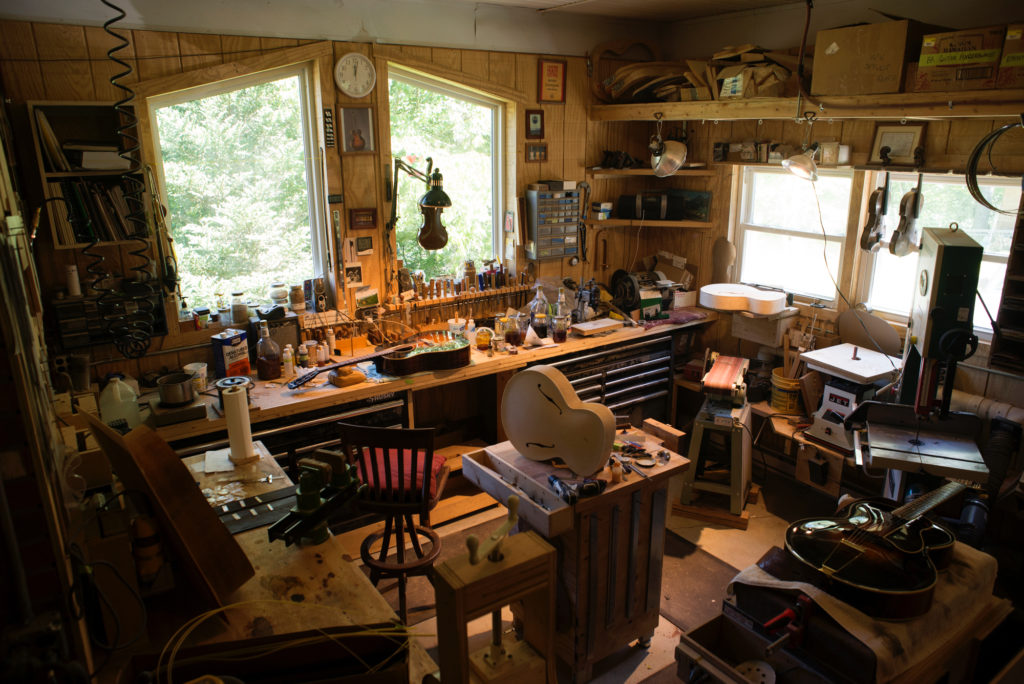
FJ: How many instruments do you build in a year?
JC: I’m slow! Not too many: a couple fiddles and maybe five guitars at most right now, and usually a few odd jobs like necks and repairs and such keep me pretty busy. I travel and play music a lot. I’m still getting my new shop tooled up and getting everything in order so when that’s all settled hope to increase my output.
I don’t do a whole lot of repair work. I get asked a lot but I’m trying to stick with the building – that’s were my passion is. I help out my friends with repairs and odd jobs, and it is hard to say no sometimes, especially if a cool old guitar comes in.
FJ: How does someone get one of your guitars? How long’s the wait these days?
JC: The best way to get a guitar is to just give a call, Facebook message or email. Phone call is the best though – we can talk about what you want and how long it might take, and then we can figure out if it’s a custom job or one of the spec models I make.
The wait is probably a year, year and a half, give or take, and maybe check with George Gruhn – I gave him one to sell last year and I will be giving him some more, so that might be a a faster way to get one.
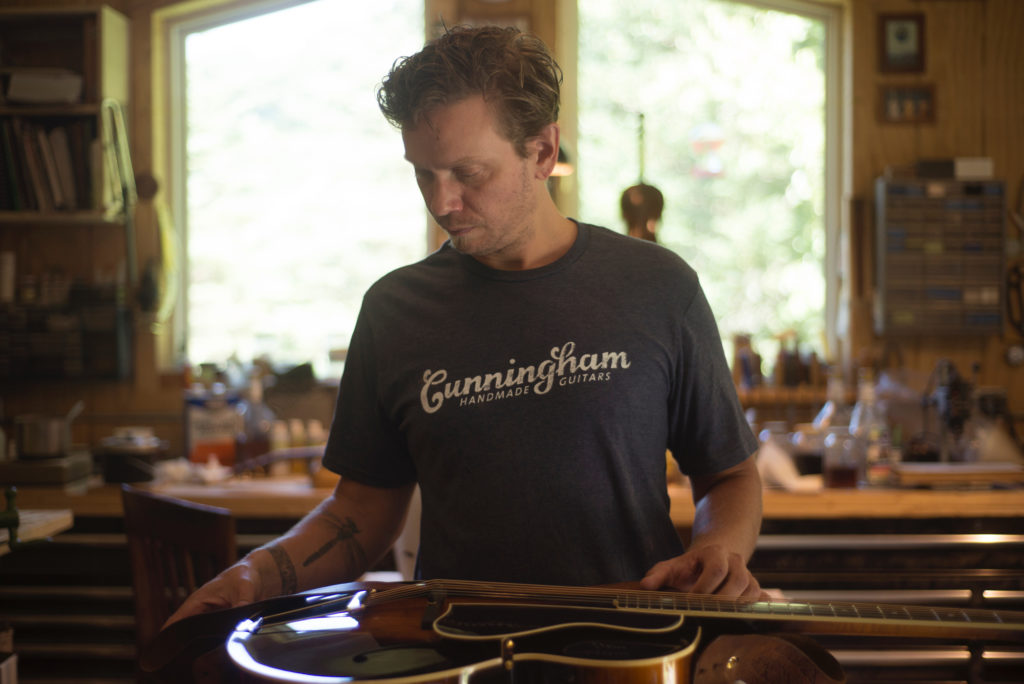
Photos by Pat Jarrett/The Virginia Folklife Program


